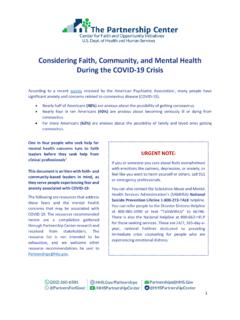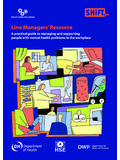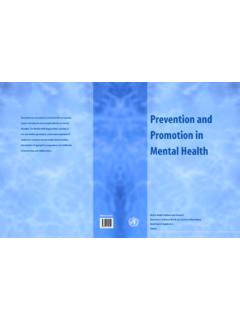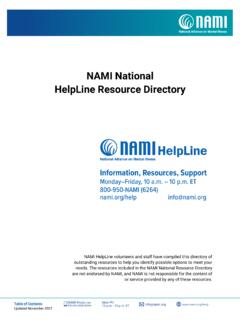Transcription of A4. Creating a Community Resource List - FRIS
1 West Virginia Training and Collaboration Toolkit Serving Sexual Violence Victims with Disabilities Collaboration 101. Creating a Community Resource List Creating a Community Resource List This module helps service providers to do the following: (1) develop an understanding of the benefits of having a Community Resource list for sexual violence victims with disabilities; (2) understand the process for Creating a list of local resources;1 and (3) gain insight into the process of Resource mapping. Key Points Identifying Community resources, also known as Resource mapping, is a strategy for improving services to communities.
2 It can be achieved by compiling a list of resources and/or by mapping out the resources, their physical locations, contact information and linkages with other resources. To help guide the work of identifying Community resources and assets, the following questions should be addressed: What is the purpose of the asset assessment and how will the results be used? What is the size/scope of the Community being assessed? What people are available to do the work? How much time do you have for the task or how much time can you allow? How much money and other resources are available for incidental expenses?
3 There are two basic complementary approaches to identifying resources, with one approach focusing on the resources of groups that offer services in the Community for sexual violence victims with disabilities and the other focusing on the resources offered by individuals in the Community . Once you have collected Resource information, it can be helpful to put it on a map. Maps are good visual aids when data creates a picture, understanding and insight often increase. There are several possible approaches to Creating a map: Mark the resources on a large Community street map, use a computer program to create a more flexible and sophisticated map, or even diagram resources on a chart, rather than an actual map, to show linkages among the different categories of resources.
4 A4. Creating a Community Resource List2 Purpose Resources available to sexual violence victims with disabilities are not always readily identifiable. For example, some services may not be widely advertised and instead be provided by an agency only upon request. Therefore, service providers must be aware of all of the available resources that sexual violence victims with disabilities might potentially need. Compiling a list of those available resources creates a tool to help provide victims with efficient, seamless service delivery, regardless of their point of entry into the system.
5 This module is designed to help service providers to do the following: (1) develop an understanding of the benefits of having a Community Resource list for sexual violence victims West Virginia Training and Collaboration Toolkit Serving Sexual Violence Victims with Disabilities Collaboration 101. Creating a Community Resource List with disabilities; (2) understand the process for Creating a list of local resources; and (3) gain insight into the process of Resource mapping. Objectives Those completing this module will be able to: Define Resource mapping and identify the benefits of Creating a Community Resource list; Understand the basic issues to consider when Creating a Resource list; Identify the different approaches for Creating a Resource list; and Convene a work group and create a Resource list.
6 NOTE: Agencies may be concerned about the time required to create and maintain a comprehensive Resource list for sexual violence victims with disabilities. Keep in mind that this Resource list can first be created on a small scale and incrementally expanded in scope. Part 2. Discussion in this module provides participants with an opportunity to begin working collaboratively to create such a list. Also, you most likely are not starting from scratch not only does your agency probably have a general Resource list, but in the process of completing other modules in this toolkit, you may have already begun to gather information about resources for victims with disabilities and have initiated relationships with agencies that provide relevant services.
7 PART 1: CORE KNOWLEDGE What is Resource mapping? Identifying Community resources, also known as Resource mapping, is a strategy for improving services to communities. It can be achieved by compiling a list of resources and/or by mapping out the resources, their physical locations, contact information and linkages with other resources (see below for more on different kinds of maps). The resulting map can be an excellent visual of what resources are available to the Community and how to connect victims with those resources. To help guide the work of identifying resources, the following questions should be addressed: What is the purpose of Resource mapping and how will the results be used?
8 Consider whether the list/map will be shared with other agencies and professionals or be available for in-office use only. Will it be used to initiate some type of action, and if so, what and how? Will it be used to improve services? Do you want to narrow the scope of the Resource list to a specific group of victims ( , victims with cognitive disabilities) or establish criteria for including a Resource on the list ( , only affordable housing options rather than all housing options in a Community )? The answers to these questions will provide structure and direction for the mapping process.
9 What is the size/scope of the Community to be assessed for resources? It might be a specific housing development, a local neighborhood, a town or city, a region or the state. It might be necessary to identify resources outside of a particular Community if victims living there seek services in a neighboring county or state due to the lack of local services and programs. The answer to this question can not only provide focus to your information-West Virginia Training and Collaboration Toolkit Serving Sexual Violence Victims with Disabilities Collaboration 101.
10 Creating a Community Resource List gathering efforts, but also help you estimate the time commitment involved in the process. Obviously, with a larger size/scope, more work will be involved. What people are available to do the work? Is this a project achievable by one staff person or a collaborative project involving multiple agencies? Is it possible to engage local government support or a college class for such a project, since knowing the Community 's resources is in the entire Community s interest? How much time is available and allowable for the task? How much money, if any, and other supports are needed/available for incidental expenses?









